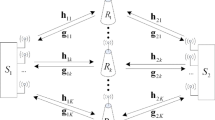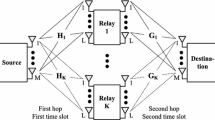Abstract
Cooperative relaying has been well appreciated to be a key concept of future wireless systems capable of yielding high network reliability and significant error rate reduction. However, in such paradigm of communication, the total limited power may be wasted without providing minimum performance requirements such as network lifetime if it is not well allocated between the cooperating nodes in an efficient way. In this work, we mainly address the problem of network lifetime limitation in wireless relay communication system by developing optimal power allocation techniques. In the communication scenario, a source sends information to a destination with the help of multiple relay nodes operating in amplify-and-forward relaying protocol. As a parameter of measurement, we particularly address the symbol error rate (SER) performance for MPSK signal using the concept of moment generating function. Due to the complexity of the closed-form SER expression, we then find a tight corresponding lower bound to show useful insights in terms of analysis. Next, we develop a cooperation strategy where only a best relay that maximizes the end-to-end signal-to-noise ratio assists the transmission to further improve the performance of the previous system. In addition, numerical results are presented to validate the theoretical analysis.
Similar content being viewed by others
References
Goldsmith A. (2005) Wireless communications. Cambridge University Press, Cambridge
MacDonald V. (1979) The cellular concept. Bell System Technical Journal 58: 15–41
Li, P., Zhang, C., & Fang, Y. (2011). The capacity of wireless ad hoc networks using directional antennas. IEEE Transactions on Mobile Computing, 10, 1374–1387.
Anastasi G., Conti M., Di Francesco M., Passarella A. (2009) Energy conservation in wireless sensor networks: A survey. Ad Hoc Networks 7: 537–568
Kumar S. (2004) Mobile communications: Global trends in the 21st century. International Journal of Mobile Communications 2: 7–86
Gesbert D., Hanly S., Huang H., Shamai Shitz S., Simeone O., Yu W. (2010) Multi-cell MIMO cooperative networks: A new look at interference. IEEE Journal on Selected Areas in Communications 28: 1380–1408
Scutari G., Palomar D. P. (2010) MIMO cognitive radio: A game theoretical approach. IEEE Transactions on Signal Processing 58: 761–780
Samb, D., & Li, Y. (2010). Performance analysis of relay channel with Amplify-and-Forward in cooperative communication system’. In Proceedings of the IEEE 3th international conference on computer science and information technology. Jul 9–11, Chengdu, China.
Laneman J. N., Wornell G. W. (2003) Distributed space-time coded protocols for exploiting cooperative diversity in wireless networks. IEEE Transactions on Information Theory 49: 2415–2525
Su W., Sadek A. K., Ray Liu K. J. (2008) Cooperative Communication protocols in wireless networks: Performance Analysis and Optimum power allocation. Wireless Personnal Communication (Springer) 44(2): 181–217
Laneman J. N., Tse D. N., Wornel G. W. (2004) Cooperative diversity in wireless networks: Efficient protocols and outage behavior. IEEE Transactions on Information Theory 50(12): 3062–3080
Anghel P., Kaveh M. (2004) Exact symbol error probability of a cooperative network in a Rayleigh-fading environment fading channels. IEEE Transactions on Wireless Communications 3(5): 1416–1421
Ikki S., Ahmed M. (2007) Performance analysis of cooperative diversity wireless networks over Nakagami fading channel. IEEE Communication Letters 11(4): 334–336
Deng X., Haimovich A. M. (2005) Power allocation for cooperative relaying in wireless networks. IEEE Communication Letters 9(11): 994–996
Torabi, M., Ajib, W, & Haccoun, D. (2009). Performance analysis of amplify-and-forward cooperative networks with relay selection over Rayleigh fading channels. In Proceedings of the IEEE 69 vehicular technology conference spring, April 26–29, Barcelona, Spain.
Zhao Y., Adve R., Lim T. (2006) Symbol error rate of selection amplify-and-forward relay systems. IEEE Communication Letters 10(11): 757
Ikki, S., & Ahmed, M. (2008). Performance of multiple-relay cooperative diversity systems with best relay selection over Rayleigh fading channels. Eurasip Journal on Advances in Signal Processing, 2008, 1–7.
Seddik K. G., Sadek A. K., Su W. F. et al (2007) Outage analysis and optimal power allocation for multi-node relay networks. IEEE Signal Processing Letters 14(6): 377–380
Bertsekas, D. P. (1982). Constrained optimization and Lagrange multiplier methods, vol. 1. Computer Science and Applied Mathematics, Boston: Academic Press.
Brennan D. G. (2003) Linear diversity combining techniques. Proceedings of the IEEE 91(2): 331–356
Simon M. K., Alouini M.-S. (2000) Digital communications over generalized fading channels: A unified approach to performance analysis. Wiley, New York, NY, USA
Author information
Authors and Affiliations
Corresponding author
Rights and permissions
About this article
Cite this article
Samb, D., Yu, L. Performance Analysis of Amplify and Forward Cooperative Relaying Protocol in Wireless Communication System. Wireless Pers Commun 70, 969–983 (2013). https://doi.org/10.1007/s11277-012-0732-1
Published:
Issue Date:
DOI: https://doi.org/10.1007/s11277-012-0732-1




